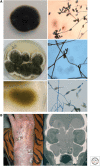Black Molds and Melanized Yeasts Pathogenic to Humans
- PMID: 25384772
- PMCID: PMC4526721
- DOI: 10.1101/cshperspect.a019570
Black Molds and Melanized Yeasts Pathogenic to Humans
Abstract
A review is given of melanized fungi involved in human infection, including species forming budding cells and strictly filamentous representatives. Classically, they are known as "phaeoid" or "dematiaceous" fungi, and, today, agents are recognized to belong to seven orders of fungi, of which the Chaetothyriales and Pleosporales are the most important. Infections range from cutaneous or pulmonary colonization to systemic or disseminated invasion. Subcutaneous involvement, either primary or after dissemination, may lead to host tissue proliferation of dermis or epidermis. Particularly in the Chaetothyriales, subcutaneous and systemic infections may occur in otherwise apparently healthy individuals. Infections are mostly chronic and require extended antifungal therapy and/or surgery.
Copyright © 2015 Cold Spring Harbor Laboratory Press; all rights reserved.
Figures



References
-
- Abliz P, Fukushima K, Takizawa K, Nishimura K. 2004. Identification of pathogenic dematiaceous fungi and related taxa based on large subunit ribosomal DNA D1/D2 domain sequence analysis. FEMS Immunol Med Microbiol 40: 41–49. - PubMed
-
- Adler A, Yaniv I, Samra Z, Yacobovich J, Fisher S, Avrahami G, Levy I. 2006. Exserohilum: An emerging human pathogen. Eur J Clin Microbiol Infect Dis 25: 247–253. - PubMed
Publication types
MeSH terms
Substances
LinkOut - more resources
Full Text Sources
Other Literature Sources
Medical
